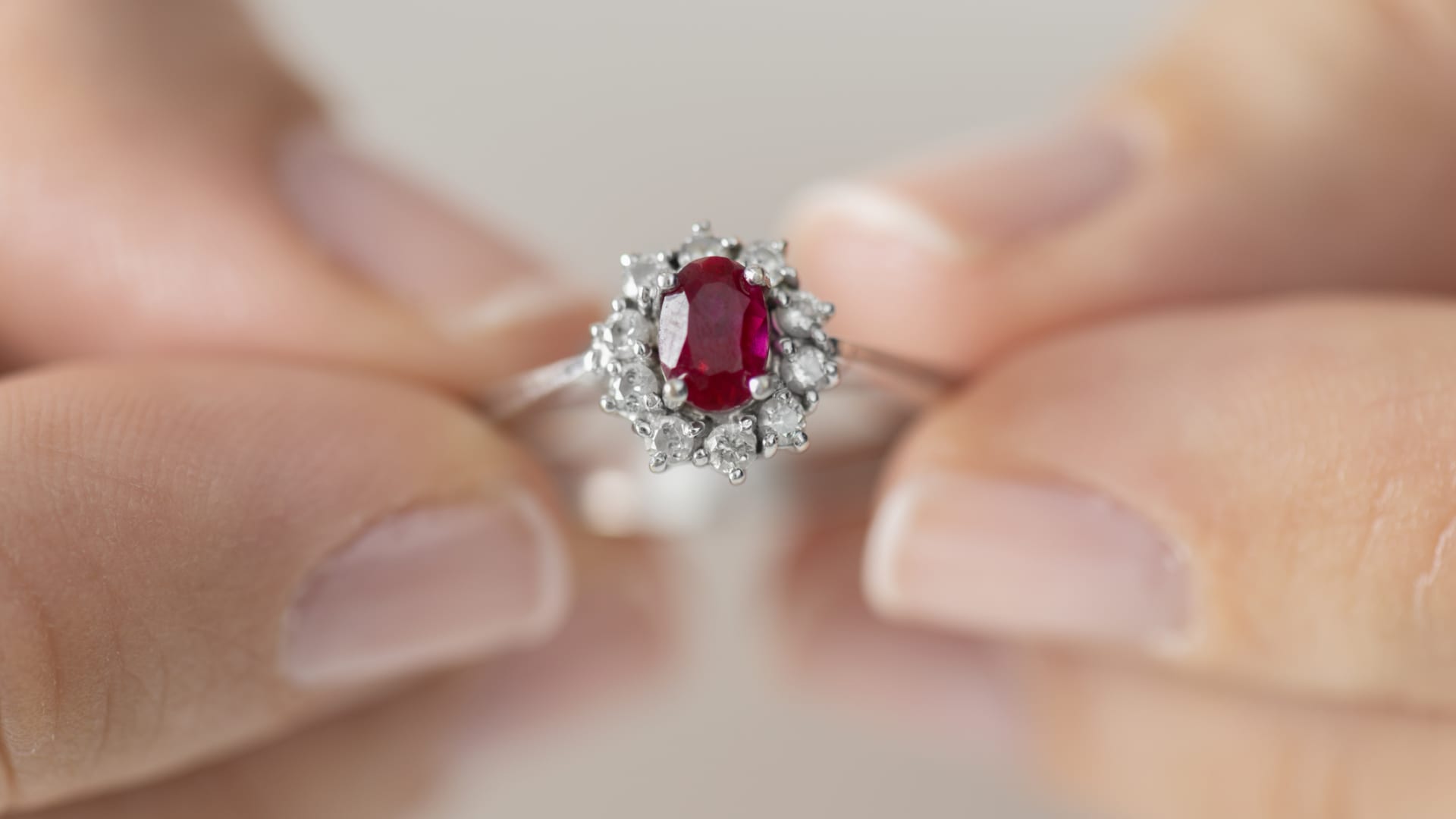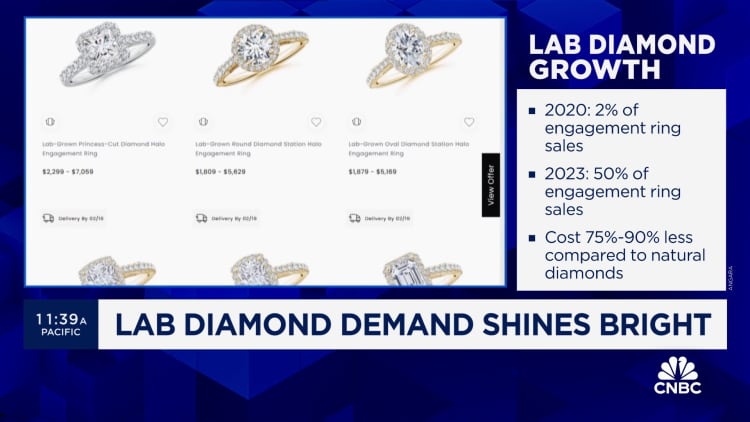
Luxury precious rings in a row on display in a jewelry store at a high-end shopping mall.
Craig Hastings | Moment | Getty Images
Roses are red, violets are blue, gemstones are hot and prices are too.
Valentine’s Day has long been one of the most popular days of the year for jewelry and engagements. U.S. consumers will spend a record $6.4 billion on jewelry around Valentine’s Day this year, representing 10% of the total annual spend, according to Ankur Daga, founder and CEO of fine jewelry e-commerce company Angara.
This year, the contents of those ring boxes may look a little different from the traditional, natural diamond solitaire.
“We’re seeing a shift in much larger center stone engagement rings, primarily as a result of lab-grown diamonds, and sapphires and rubies tend to be very hot,” Daga said.
A decade ago, about 5% of engagement rings were colored gemstones, according to Daga. Now, it’s more than 15%.
More than 20% of people would upgrade their engagement ring to a colored gemstone — such as an emerald, yellow diamond or pink sapphire, for example — if they could, Daga said, citing results of a survey Angara commissioned of more than 2,000 people.

Industry giant Signet Jewelers is seeing the same gemstone trend in the wedding category as well as in fashion pieces. It’s seeing particular pickup in sapphire, morganite, London Blue Topaz, aquamarine and green quartz stones, according to Signet, which sells jewelry under brand banners including Zales, Jared and Kay.
Beyond engagement rings, Signet said amethyst and ruby are always popular stones for the Valentine’s season. Amethyst is the birthstone for February, and ruby red evokes the color of love.
But the shift toward colored gemstones could also be a reflection of the customer who wants a “more distinctive piece,” said Brilliant Earth CEO Beth Gerstein. The company, which specializes in lab-grown diamonds, also offers gemstones that span the color spectrum.
“We also see gemstones resonating because people love the personalized approach of birthstones,” Gerstein said, adding that gemstones, in general, “cater well to a Gen Z audience, as we know they want something that is unique to them and reflective of their personal style.”
Gemstones seen displayed for sale during an event.
Peerapon Boonyakiat | Sopa Images | Lightrocket | Getty Images
Supply pressures
Demand for gemstones is increasing just as supply of many natural gemstones is getting tighter.
Rubies and select exotic stones have become more expensive and difficult to source due to quality concerns and limits on the regions that stones can be sourced from. Those challenges have given rise to lookalike stones such as garnet in place of rubies, for example.
“There’s only really one mine in Madagascar that produces the bulk of the world’s rubies,” said Daga of Angara. “If we look at sapphire, Burmese and Kashmir mines are now shut so you really have Sri Lanka and Madagascar as the two primary providers. Even on the emerald side, we see that Zambia and Colombian emerald supply is much harder to come by, at much higher prices, than in the past.”
Hands holding a diamond ring with a ruby.
Solidcolours | Istock | Getty Images
Wholesale prices for sapphire gemstones are up 12% per year over the past three years, Daga said. For emeralds, its 13%, and rubies, 17%.
“Some of the more niche stones, like pearls and opals, are up over 20% a year. Tourmalines are up all the way up to 36% a year,” he said.
By comparison, the compound annual growth rate of the S&P 500 stock index is 10.5% over the past three years.
Daga argues the shift in supply and demand of gemstones — and consumers’ general desire for color in many luxury goods, such as gemstone bezels on Rolex watches or brightly colored Ferraris — makes the stones a more attractive asset class.
“If you look at Bonhams, Sotheby’s and Christie’s auctions very recently, over half of the gemstone lots have sold over the high estimates, and there’s quite a few lots that are selling three times plus of the high estimate,” Daga pointed out. “We’re seeing this transition to investors really looking at color as an inflation hedge and as a growth vehicle for investments.”
A 25.86 carat vivid yellow diamond is displayed at an auction preview in Hangzhou, Zhejiang Province, China, on Dec. 19, 2023.
Costfoto | Nurphoto | Getty Images
While the market for diamonds has moved dramatically over the past three years toward lab-grown alternatives — representing 50% of diamond engagement rings purchased last year, according to Daga — the same isn’t yet true for colored gemstones.
Roughly 75% of customers shopping for colored gemstones still prefer natural, he said.
“While [lab-grown gemstones] are chemically, physically and optically identical to natural, I think the key difference is they look so perfect as a result where most colored gemstones have inclusions,” Daga explained, using an industry term for what the casual admirer might call imperfections. “Those inclusions are really what make them pretty or will make them unique and different.”
— CNBC’s Cait Freda contributed to this report.
Don’t miss these stories from CNBC PRO:
